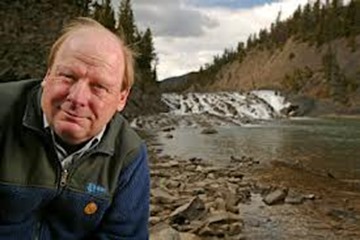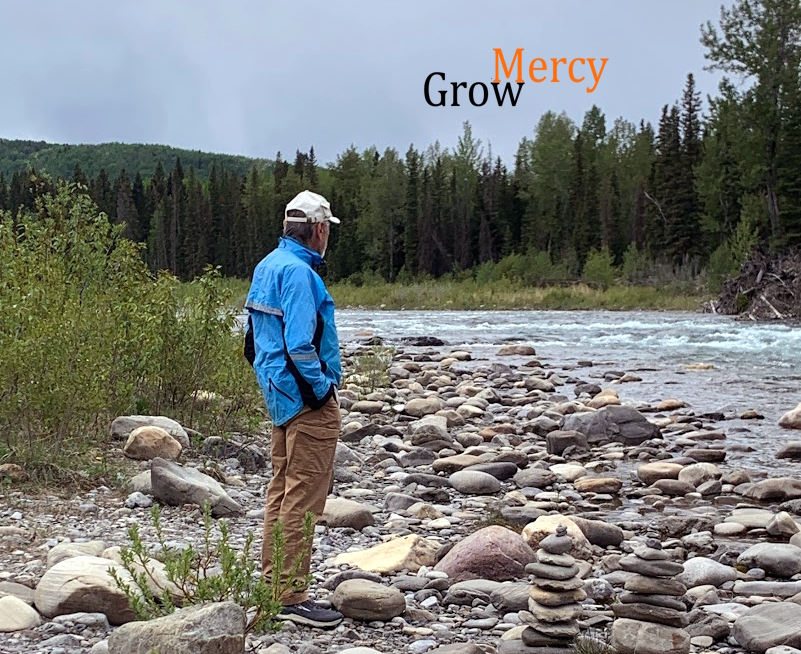Do you remember that hydrological cycle diagram you created in grade school? You drew grass and trees and maybe some hills going down to an ocean. You had the sun streaming away in one corner and clouds scattered across the top. Then you mapped in a series of neat lines—dashes with arrows—showing sea water evaporating, making the clouds, and then more arrows showing clouds moving gracefully over land, spilling themselves, making the trees grow, the runoff lapping down to a lake, into a river, and back to the sea, where those glorious yellow rays of sun moved water vapour back up into the clouds, and it all was a wonder to behold. Especially if you saw Jane Pohl’s grade five illustration: as though sketched by God’s own hand.
Well, anyway, if you still have it, (I’m sure you do), take a red marker to it. Make the lines more intense, bold up the clouds. And that slow overlaid circle that suggests bucolic order? break it up. Make erratic swirls instead. And make more of those dashed lines, many more, make them tight, like on a topographical map to show  heightened vigour, because as Robert Sandford says—who has these persuasive titles: Director of the Western Watersheds Climate Research Collaborative (WWCRC) and EPCOR Chair for the Canadian Partnership Initiative of the United Nations ‘Water for Life’ Decade, and who happens to be a resident of Canmore, and who was interviewed on CBC Radio the day after the southern Alberta flood—
heightened vigour, because as Robert Sandford says—who has these persuasive titles: Director of the Western Watersheds Climate Research Collaborative (WWCRC) and EPCOR Chair for the Canadian Partnership Initiative of the United Nations ‘Water for Life’ Decade, and who happens to be a resident of Canmore, and who was interviewed on CBC Radio the day after the southern Alberta flood—
“Warming temperatures are causing water to move more energetically through the hydrological cycle, changing the rain patterns, and increasing the frequency and duration of extreme weather.”
It’s a fact we all absorbed in school: the warmer the air, the more water it holds. In fact, according to the Clausius-Clapeyron Relationship, for every one degree of temperature increase, the atmosphere will hold seven percent more water. But all this extra water creates a problem, it sets off something called a water vapour feedback: a kind of hellish loop where the increase in water vapour, which by the way is a very strong greenhouse gas, adds to the warming already experienced due to the other greenhouse gases, which in turn, increases the amount of water vapour in the atmosphere…you get the picture. And all the extra water vapour in the atmosphere is at the expense of water locked up in glaciers, the snow pack, and in the ground.
Sandford, who is all about water security and sustainability, keeps a close eye on the cyrosphere. And he’s worried. There’s a major recession happening. Glaciers, all important for ecological balance and stability, are disappearing.
But he’s been talking about this for a while. And just last fall a hundred or so climate experts gathered in Banff for a conference entitled, Storm Warning: Water, Energy, and Climate Security in a Changing World.
It was Stanford, who had come from just down the road, who brought a rather dire message regarding the effects of rising temperatures on the snow pack and on the hydrological cycle. He gave a talk called, ‘The Snows of Yesterday and the Future Water Supply of the Canadian West,” outlining how all this stuff has given rise to what he and other hydrologists call ‘the loss of hydrological stationarity.’
“It’s clear that the trend is continuing and we’re now very concerned from research that has been collected that it might be accelerating,” he said. “If we had this conference 10 years ago we’d still be dealing with projections with a lot of anxiety about how accurate the projections were. We’re no longer looking at models — we’re seeing widely demonstrated examples.”
He was referring of course to events like hurricane Katrina, super storm Sandy, the 2005, 2-hour, 700 million dollar storm in Toronto.
When asked about the causes of this past week’s flood, Sandford talked about the loss of Arctic sea ice and snow pack, giving way to massive water vapour rivers—atmospheric rivers ten times the size of the Mississippi—moving water around the world…and to places where it doesn’t usually go.
Here in Alberta, the 2005 flood was called a once-in-a-century event. Last week’s flood was called a once-in-a-thousand-year-flood, by a government official (didn’t catch the name). Wish it was true. But according to Robert Sandford, we can begin to expect these once-in-a-century storms, floods, droughts, far more often. Extreme, says Sandford, is probably the new norm.
To hold assumptions about the relative ‘stationarity’ of our climate is now foolhardy and indefensible. As for those computer models on how wind and water will behave, well, it’s back to the white-board.
Still, Sandford is not without hope. Although at this stage, fixing the problem will take more than reducing carbon dioxide emissions. It’s a matter of slowing the trend, working, with great efforts, towards restoring the ecology through a collective will. And adapting.

what’s obvious:
1. there has been climate change throughout the earth’s history (see ice age)
2. humanity has demonstrably caused pollution in recent history, and has also cleaned up
what makes sense:
1. the increase in burning of fossil fuels can result in increased warmth of the atmosphere and the ensuing results as described by Sanford.
the challenge: to clean up after ourselves, as mother taught us. I think we’re smart enough.
Stephen, you are sounding pretty scientific in this piece. Welcome to my world! But seriously, the phrase “the snows of yesterday” from the title of Sandford’s talk last fall is pretty powerful. That is already the situation in Pennsylvania, and during some winters (not this past) in Upper Michigan where I grew up. Anyone born before 1970 recounts snowbanks, and snowmobiles, and long ski seasons. Now the younger set rejoice with water parks and longer growing season, and have learned to ski on artificial snow, that is much more like ice pellets than the powder I knew as a child.
I fell in love with the glaciers in Alaska, staring for hours in case they are gone if I ever get to return. At Exit Glacier, they were measuring the retreat in days, not decades due to record high temps.
Extreme is the new norm, as evidenced by the IPCC publishing the SREX report on how to reduce damage and risk, rather than how to mitigate greenhouse gases.
You are obviously and sensibly a voice of reason Sam.
Thanks Diane, I’m hardly up to your world. My expertise is limited to crayon illustrations. But yes, the speed of climactic change is daunting. I think Sandra Stiengraber echoed your snow-less experience in an article a couple of Orion’s ago. A sad piece. (I’m not familiar with the reports you mention. Perhaps you could write a post about that?) Thanks again Diane.
Well Stephen, crayon illustrations or not, your comments sound pretty informed. Here is a link to the report I referred to: http://ipcc-wg2.gov/SREX/
I did do a bit of a post on this report last fall when attending the U.N. meetings: http://moraviancollegeatunfccc.blogspot.com/2012/12/on-role-of-civil-society-in-un-process.html (although there are other messages in this piece).
I am kicking around some ideas prompted by my observations in Alaska, but the creative words seem to be evading me right now!
For someone not even at the crayon stage, is there any related explanation for why my friends in Colorado and Nebraska are experiencing continued drought?
Your “wax crayons” have rather sharp points – our grandchildren have a “future shock” coming at them.
For Joyce – this rather technical piece in a recent media outlet discusses the ongoing droughts and possible explanations: http://readersupportednews.org/news-section2/312-16/18200-is-the-loss-of-arctic-ice-making-western-droughts-worse
The situation is made worse in the west/southwest by the increase in population and user demand for water, old water-right agreements (unique to the west), etc. Basically, too many straws in the glass. But a shifting climate and perhaps loss of artic ice impacting weather patterns shares some of the blame. And yet many of the states with extreme water shortages, continue to use water for hydrofracturing. Makes no sense.
Diane, thanks so much for the additional links. I’ll look forward to your Alaskan observations. Also thank you for the “Arctic ice – drought” article. A good addition to the discussion.
Joyce, thanks for the question. I too struggle with comprehending all of the information, sometimes, seemingly contradictory. But I think it’s important to make the effort. So I appreciate those (science writers like Diane) who can make things accessible. As to your question, what makes sense for me, gleaned from the article Diane referenced, is the wide “precipitation shifts” we are now experiencing. So floods and droughts are part of the same underlying problem.
Raymond, I believe your pithy summation is all too accurate.
Indeed, the information put out by media and other sources makes it difficult for the public to understand the complexities of the changing climate. The magnitude of the potential impact of this phenomenon makes it difficult for all of us to comprehend and to know what to do.
The science is much less contradictory, but it is complex and there are still unknowns since we use past history and evidence and modeling to try to predict the future climate on a global scale. That is tough as there are regional differences expected and the resolution of the modeling, while improving rapidly, is still too course.
But yes, Stephen, precipitation shifts (caused by a number of factors including the decreased Arctic ice) are predicted; hence the drought in some areas and severe flooding in others. And all of this is overlaid on normal fluctuations in short term and seasonal weather variations that differ by geography, latitude, altitude, proximity to oceans, etc. By coincidence, I had just marked that article that I sent the link to for future reading, but moved it up on the list when I saw Joyce’s question.
I always welcome questions!
Great article Steve.
Thank you Joanne.